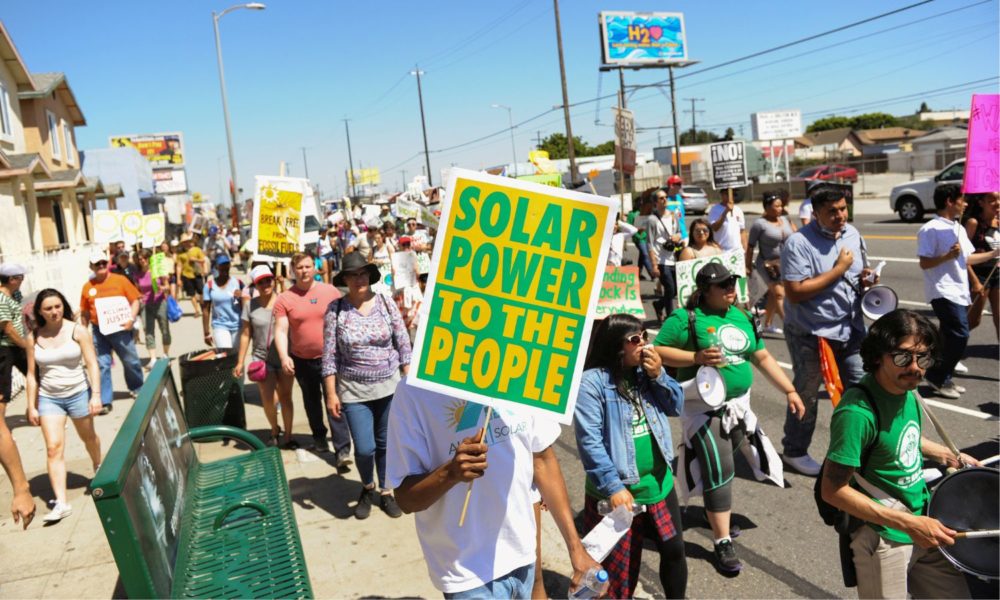I was invited to speak at a panel discussion last Wednesday as part of The Economist’s annual Sustainability Week, titled “What technologies are needed to avert a climate disaster?” True to the theme, I was asked about which technological innovations would be necessary to save our planet. I wanted to take this space to share some of my thoughts from the panel—and why I believe this wasn’t exactly the right question to ask.
Technology isn’t holding back climate progress
Technology is where most energy transition conversations remain focused. And yet, technological innovation is not what’s standing in the way of significant and necessary near-term climate progress. We already have so many of the foundational technological building blocks of the clean energy transition at hand: renewables, energy efficiency, energy storage, and pathways to electrifying a vast array of energy end uses. Combined, these technologies have the capacity to get us an overwhelming amount of the way there.
No question, there’s still room for technological innovation—to make existing technologies better, and to push the frontiers of what’s possible to enable the best possible outcomes for climate, for health, for equity, for affordability, for resilience, and for overall quality of life. But we could be making enormous strides right now. And yet, we aren’t. Indeed, in most scenarios today, it is everything but the technology that’s impeding progress.
Overly focusing on technological innovation will miss the basic changes needed to drive the clean energy transition at scale and at pace today, including required breakthroughs on collaboration, collective action, communication, governance, and business model reforms. These pieces are critical to unleashing necessary change—regardless of the technologies at hand—yet are too often overlooked.
The actual barriers to progress
The costs of clean energy resources like wind and solar energy and battery storage have dropped dramatically over the last decade even as their performance has improved tremendously. Now we need to rapidly accelerate the clean energy momentum already underway.
Of course, every clean energy resource has room for improvement in terms of technical innovation. But at this moment in time, the biggest hurdles to overcome are in the process and governance structures of utilities, grid operators, and regulators in deploying clean energy resources and connecting them to the grid, overcoming challenges with siting and permitting, providing access to clean energy and its benefits in all communities, and focusing on approaches that support both utility-scale and local-scale deployment.
We need to increase attention to these issues to actually achieve the levels of progress we desperately and urgently need. That means more time spent on tackling vested interests head-on. It means committing to incentives and standards that clearly align with the trajectory we need to be on across all sectors of the economy—both valuing the beneficial aspects of clean energy resources, and accounting for the negative effects of polluting fossil fuels. It means broadening access to clean energy solutions so stakeholders at every level can participate. It means updating market rules and structures to put clean energy solutions on a level playing field with legacy fossil fuels.
We also need to invest in a just transition for workers and communities dependent on fossil fuels, invest in a domestic manufacturing base for clean energy technologies, and ensure that we create good paying jobs with strong labor standards in the growing clean energy sector.
Clean energy on hold
Here’s one example of why technology isn’t the problem we need to solve: there are many, many clean energy projects that are not being developed right now because they are waiting to get access to the grid. These wind, solar, and energy storage projects total 1,300 gigawatts of electric generating capacity, which represents more than $2 trillion in investments, and is roughly the same amount needed to get the U.S. to 80 percent of electricity from zero-carbon resources by 2030.
To unleash that clean energy, we need innovation in the processes and governance structures of the institutions that operate our power grids and oversee planning for new transmission. But electric utilities and regional transmission organizations still operate under arcane market rules and structures that favor fossil fuels over renewable energy sources. We must turn our attention there first.
Right now, communities all across the country want to participate in the clean energy transition, both in terms of building up clean energy investments as well as phasing out historical sources of pollution, for which environmental justice communities have long borne a disproportionate burden. There’s tremendous interest especially in solar power—installing panels on the rooftops of homes and business, and in large-scale community installations.
But between interest and access, numerous and significant barriers stand in the way. As highlighted in a recent analysis released in partnership with UCS and Soulardarity, a Michigan-based community group, many communities are interested in their own clean-energy microgrids as part of a broader vision to gain greater local control over decisions on energy and climate. But to enable that, states and utilities need to change their rules and incentives to allow for broader participation. There are many more examples like these of the rules that need to be changed to be able to deploy clean energy at the local and national scale that’s needed.
What we really need
To ensure robust and enduring progress, it is critical that clean energy transitions are developed in concert with communities from the outset, to ensure that the solutions developed are the solutions actually wanted and needed. That is far too infrequently the case today.
I don’t know that any one city or government has mastered the formula for success on an economy-wide scale, but there are thousands of examples of communities across the US and globally that are implementing innovative solutions to deploy clean energy resources. For example, more than 50 cities in the US are already fully powered by clean energy—many of which are in California, but the list also includes places like Rockport, MO, Greensburg, KS, and Georgetown, TX. In addition, more than 170 US cities and 8 states have committed to this and are working hard toward getting there.
Importantly, it is essential for communities and workers to share their knowledge and experiences—both positive and negative—and for decisionmakers to listen, because while the needs and resources of each community are unique and will necessitate a myriad of solutions, we simply do not have time to invent the path forward independently.
Can we overcome these hurdles?
I’m optimistic that we can.
People can no longer deny climate change must be addressed. Many lawmakers acknowledge that their constituents are being hammered by climate impacts, and they see the world around them changing. Companies large and small have moved beyond pledging to reach net-zero emissions and begun the real work of implementing those commitments. And the long reign of fossil fuel-industry disinformation campaigns is being challenged by lawsuits brought by cities and states across the country and around the world. Meanwhile, we have young people taking to the streets demanding real and sustained action. The tide is turning.
Ideally, transformative change doesn’t create technological innovation only for an elite few, but ensures that the benefits flow equitably to all. Clean solutions must be scaled up globally in the time frames needed to meet climate and sustainable development goals.
Thinking beyond carbon
We have an imperative to view climate action beyond the lens of a carbon-only problem. We are presently living in a world overrun with heavily polluting fossil fuels that cause irreparable damage to public health and the environment. Fossil fuels have longed harmed marginalized communities the most, including from the air they breathe to the land and water in their backyards. Simultaneously, worsening climate impacts are rapidly shifting the literal and figurative ground on which climate solutions must be built. We need comprehensive energy policies to ensure our transition to clean energy is equitable. So, we should and must reject a carbon-only framework, or overreliance on some shiny new technological silver bullet, and advance solutions that reckon with the full complexity of the challenges—and opportunities—at hand.

